Florida's deadly snakes
The Florida Cottonmouth or Water Moccasin, is a serpent that strikes terror
in the hearts of hikers, swimmers, and freshwater fishermen. This snake
is a heavy bodied pit viper with a large triangular head. The coloration
of the Cottonmouth is variable. Older and larger snakes tens to be
uniformly black, brown to reddish brown. the young are banded with a
dark color against a lighter background. Like all pit vipers, Cottonmouths have a deep facial pit between the
nostril and the eye. Unlike
the harmless water snakes, the Cottonmouth tends to hold it's ground
rather than go into the water, when approached. The Florida Cottonmouth
swims with his head well out of the water, a trait that other water
snakes don't have.
The Eastern Diamondback Rattlesnake is the most
feared and dangerous snake in both Florida and the United States!
Diamondbacks are found throughout the state of Florida. he
average adult size of the Eastern Diamondback Rattlesnake is 36-72
inches, with the record length being 96 inches. The tail of the
Diamondback is usually a different shade, brownish or gray, and toward
the end of the tail the diamonds fade out or break into bands. The large
and thick head has a light bordered dark stripe running diagonally
through the eye and there are vertical light stripes on the snout. The
pupil is vertical and catlike. The snakes venom is produced in glands
which are located below and behind the rattlers eyes. These bulging
glands, on either side of the head help give the head a triangular
appearance. The Eastern Diamondback rattle is made of of a substance called keratin,
similar to human fingernails. At birth, a rattlesnake has only a single
button at the end of its tail. As the snake grows, another loosely
interlocking segment is added each time it sheds its skin.
The
legendary and colorfully banded Eastern Coral Snake can be
distinguished from the Scarlet Snake and the Kingsnake by its blunt
black snout and the fact that its red and yellow bands touch each other.
"Red on yellow, kill a fellow" is an old jingle that
most Florida children (and adults) are familiar with. It is a quick way
to know if the snake you see is a deadly coral snake or one if it's
mimics, the Scarlet Kingsnake or the Scarlet Snake. Coral snakes have a
wide black band touching a smaller yellow band, with a third band of red
surrounded on both sides by the yellow bands. The tail is black and
yellow, without any red rings. Another distinguishing feature of the
Eastern Coral Snake is that it's rings go all the way around their body,
although they are not as intense on their bellies. The Scarlet snake has
both a red head and a white belly, two easy features to distinguish the
two. Most coral snakes are less than thirty inches long, averaging
between 20 to 30 inches. The record length for a Coral Snake is 47.5
inches long.
The
Feisty little dusky pygmy rattler is rarely longer than twenty inches,
and is common throughout the state of Florida. The Dusky Pygmy
Rattlesnake is a hot-tempered snake, usually striking repeatedly at the
slightest threat. This pit vipers venom is very potent but the dose it
delivers is small. Although the Pygmy Rattler vibrates its tail when
annoyed, the little rattles are barely audible, sounding more like the
faint buzz of an insect. The Dusky Pygmy Rattlesnake is a small snake, but very thick for its
size. The top of the triangular shaped head is covered with nine large
scales. The body color is light to dark gray. A longitudinal row of
black or charcoal, transverse blotches disrupts a reddish brown stripe
running down the middle of the back. Dark spots on the side line up with
the blotches. The tail is slender and ends in a miniature rattle. The
belly is heavily mottled with black and white.
The Southern Copperhead inhabits the Florida panhandle and is not found in southern Florida. The average length of adult copperheads is 30 inches. They have an
unmarked copper-colored head, reddish-brown, coppery bodies with
chestnut brown cross bands that constrict towards the midline.
Copperheads are thick-bodied and have keeled scales. Copperheads
feed on baby cottontails, swamp rabbits,
rats, mice, birds,
snakes,
lizards, baby turtles,
frogs,
toads, and insects, especially grasshoppers and
cicadas.
In
Florida, the Timber Rattlesnake is often called the Canebrake Rattler. The Timber
Rattlesnake is not as aggressive as the
Diamondback. This viper
will usually try to slither away when approached, but if it is stepped
on on, the Timber Rattlesnake will probably strike. The venom of the
Timber rattlesnake is potentially lethal! The adult Timber or Canebrake Rattlesnake is usually 36-60 inches long,
with the record being 74.5 inches. Males get larger than females. The
reddish brown stripe running down the center of the back is disrupted by
a series of large, black, chevron-like crossbands on the pinkish gray or
tan body. The tail is uniform black. The head is large and sometimes
with a dark diagonal line through the eye or just behind the eye. The
pupil is vertical and catlike. The tail of the Canebrake Rattlesnake
ends in a rattle.

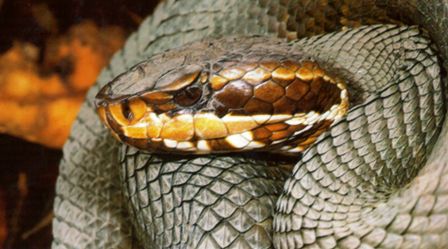
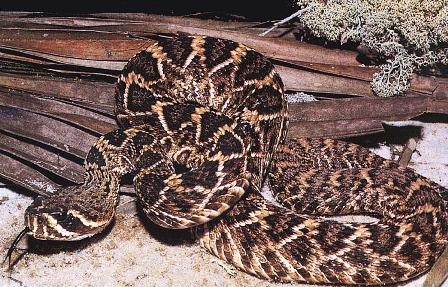
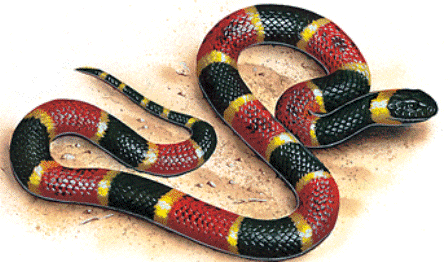
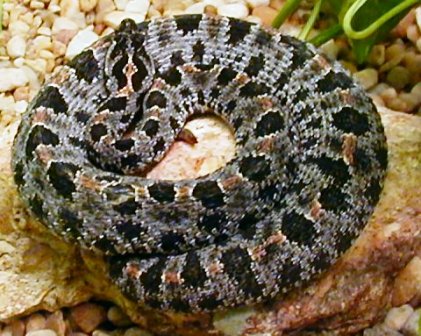

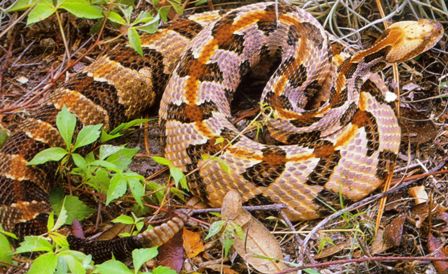

Comments
Post a Comment